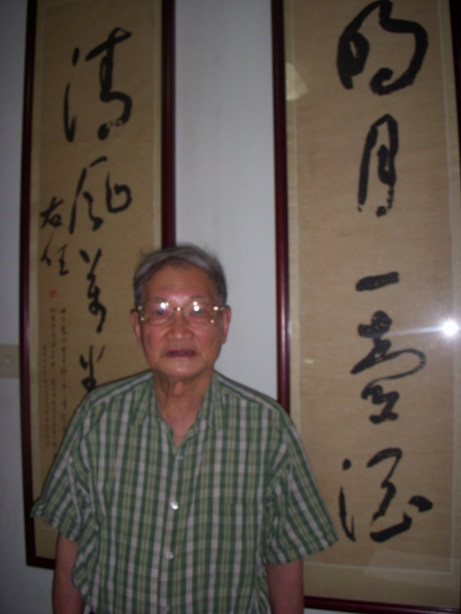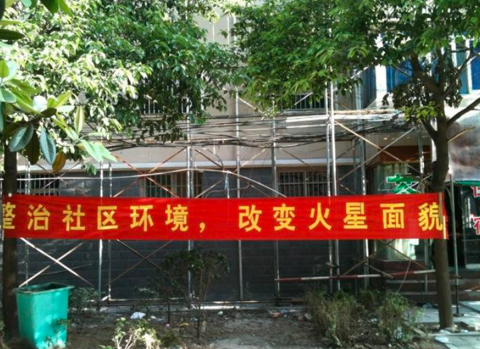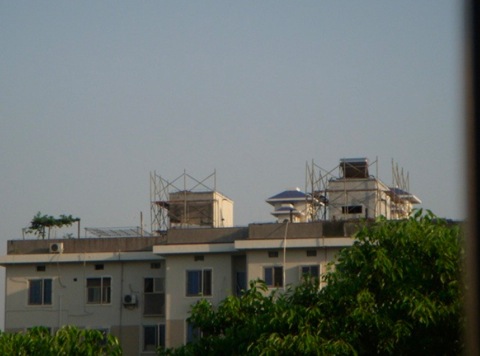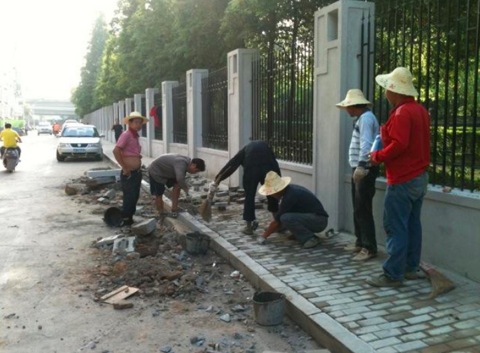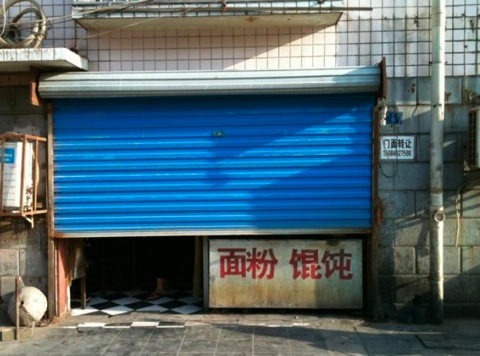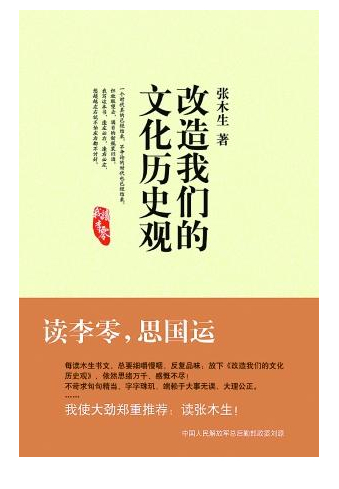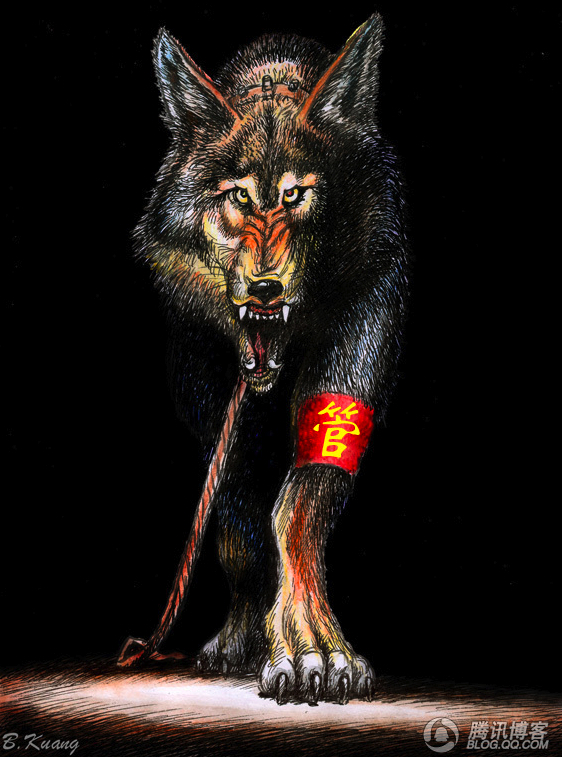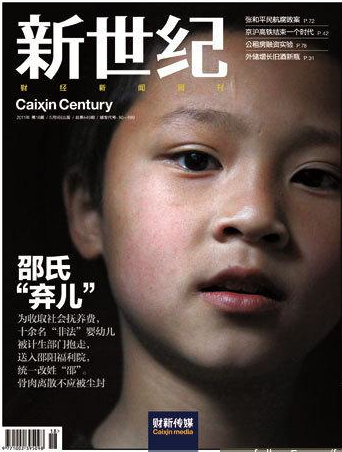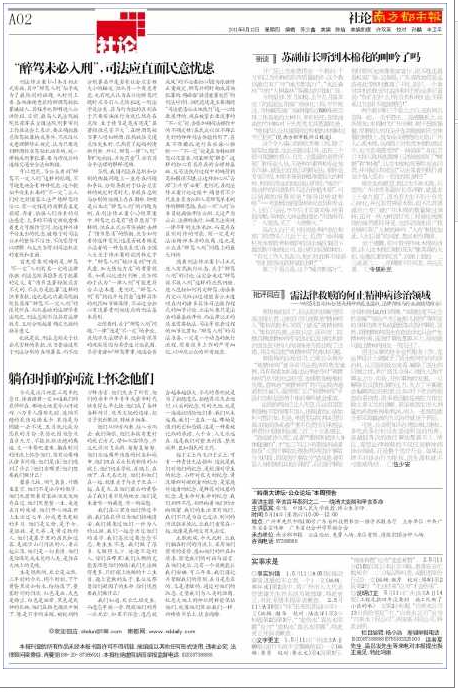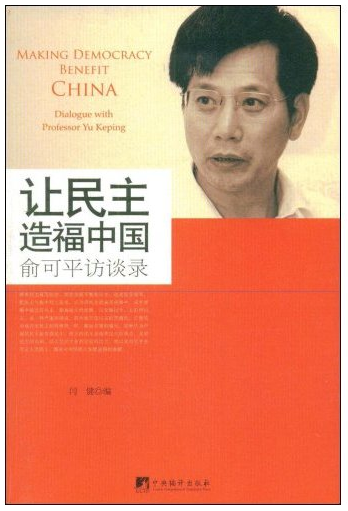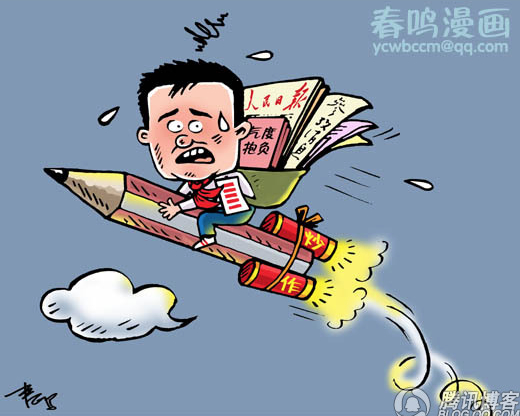Chinese authorities have been unrelenting in the control of the media in recent months, and the general consensus among working journalists in China is that things are worse now than they have been in years. But censorship — what the Chinese Communist Party refers to as “guidance of public opinion” — is not a cut-and-dried issue in China’s complex media environment. Even as control is asserted and re-asserted, we continue to see striking examples of Chinese media pushing the limits.
A rare essay last month openly challenged the legacy of Mao Zedong, an act unprecedented in contemporary China. Last week, Southern Metropolis Daily published a courageous editorial commemorating the third anniversary of the 2008 Sichuan earthquake, and referring obliquely but unmistakably to the artistic works and political activism of detained artist Ai Weiwei (艾未未).
In its May 14 edition, released on May 11, the day before the Southern Metropolis Daily‘s “line ball,” New Century (Caixin Century) magazine, published by Caixin Media, struck hard with a breakthrough investigative report on the systematic abuse of state “family planning” policies — or the so-called “One-Child Policy” — by authorities in Hunan province [English-language report HERE].
The New Century report, written by journalist Shangguan Jiaoming (上官皎明), is the first in China’s domestic media to deal openly with the uglier side of China’s national family planning policies, and is arguably one of the most important investigative reports to appear in China in recent years (in which challenges to investigative reporting have been numerous). The report shows not only that children were forcibly taken from farmers in Hunan and placed in welfare homes, but also that they were sold for profit by authorities to families in Western countries, including the United States.
On the eve of the publishing of this important work, Shangguan Jiaoming circulated a letter among friends and colleagues, asking them to give the report attention and share it with others, noting the likelihood that action would swiftly be taken against it. The journalist also shared a fuller version of the report, which we have pasted below our translation of the letter.
Hello Everyone!
Respected teachers and friends, I present to you a recent investigative piece of mine, the recent cover story in Caixin’s New Century weekly magazine, “Lost Babies” (邵氏婴儿). This report is divided into three parts, the first “Babies Snatched Away” (抢婴), the second “The Moneymaking Proposition” (生意经), and the third “Come Home, Child” (宝贝回家), together coming to 15,000 words.
Completing this group of reports was the work of four years. My first investigations were carried out in the first half of 2007, but I was later forced to give up the topic owing to its sensitivity. In the years that followed, I carried out many investigations, but ultimately I had no way of publishing these as they made ugly revelations about national “family planning” policies. This year, with the support of Caixin Media, I carried out deeper investigation of this matter in April.
This year, as both China and the United States were issuing their respective reports on human rights [concerning one another], I carried out deep in the mountain region of Longhui County (隆回) in Hunan province investigative reporting that was most intimately connected with questions of “human rights.” And this matter had to do as well with US-China relations — for many years, family planning departments in Hunan have treated the sons and daughters of farmers [in Hunan] as “illegal babies” to be confiscated and snatched away. When money was paid, they were released [back to their families]. When money was not paid, they were sent off to welfare homes — and these welfare homes then “sold” these babies off through foreign adoption channels to America and other [countries] overseas.
This human tragedy sound almost too wicked to believe, and yet it is a fact. The parents of sons and daughters snatched away have fought relentlessly for years, and their stories are so absurdly fantastic that they shocked this investigator. When I investigated this story during the first half of 2007, my grasp of the facts was limited to the confiscation of these children of farmers and their consignment to welfare homes, and stopped there. But my investigations this year development to such a point that I was able to confirm that children had been sent off to America, Holland and other countries. I also reached knowledgeable people on the U.S. side, who were able to provide even more information.
While the news never stops, this is perhaps the most important “human rights report” I will achieve this year, so I hope everyone will give it their attention. Attached is my first draft of the report (with some differences from the version finally published). On Monday, we will formally publish the story, video interviews, photos and other materials on the Caixin Media website (http://www.caing.com/)
It is very possible the report will be quickly “harmonized”. I humbly request that you teachers and friends pass the report along, and offer your comments.
Additionally, in the process of doing my on-the-spot reporting [for this piece], I took 3-4 hours of video and numerous photos as well as conducted audio interviews. In good time, I intend to edit these into a documentary called “Snatched Away” (抢婴) of around 30 minutes or so, so I hope everyone will stay tuned.
Thank you!
Respectfully,
Shangguan Jiaoming (上官皎明)
May 10, 2011
—————
封面报道
2002 至 2005 年,在湖南省隆回县,以收取社会抚养费为名,诸多“非法”婴幼儿被计生部门抢走,而后以弃婴的名义送入福利院,多数被领养。近年来,部分孩子被找到下落, 有些已经远在美国、荷兰等国。那些被抢走的孩子的家长们,至今还在寻亲路上
邵氏婴儿
□本刊记者 上官敫铭 | 文
漫漫寻亲路上,湖南人杨理兵随身携带着一张压了层薄膜的照片。照片上的女孩叫杨玲, 是他的第一胎孩子,算起来今年应该七岁了。
2005 年,杨玲尚在襁褓中,就离别了亲人。她不是被人贩子拐跑,而是被镇里的计生 干部以未交“社会抚养费”为名抢走了。
四年后,杨理兵终于得知女儿的下落——已是远在美国。
2009 年的一天,杨理兵和妻子曹志美在湖南常德一家酒店里,从一位素不相识的人手 中,得到女孩的两张照片,“我一眼就能肯定,她就是我的女儿。”杨理兵说。杨家的遭遇并非孤例。如今,隆回县有数十名婴儿曾被计划生育部门抢走,与父母人各 天涯。当地计生部门的解释是:这些婴幼儿多是被农民“非法收养”的弃婴。但实际上,有相当一部分婴幼儿是亲生的;更甚者,有的并非超生儿. 2002 年至 2005 年间,以违反计划生育政策为由、强行抱走婴幼儿的行为,在隆回县高平镇达到高潮。多年后,因部分家长锲而不舍的寻亲,类似事件浮出水面,甚至波及美国、 荷兰等国。
上篇
抢婴
锁定目标后,计生工作人员少则四五人,多则十余人,在村干部的带领下,迅速包围目标家 庭,将婴幼儿强行抱走。赎回小孩的惟一条件,就是交钱湖南邵阳隆回县,是一个国家级贫困县。从县城北行 70 多公里,到达高平镇。这是一 个位于大山群中的乡镇,人口 7 万多人。
看似人口不多,长年来,高平镇却面临着计划生育的压力。
上个世纪 70 年代初,中国开始推行以“一胎化”为主要标志的计划生育政策。1982 年, 计划生育政策被确定为基本国策。当时,和全国很多地方一样,湖南省也对计划生育工作实行“一票否决”制。违反《人口与计划生育法》和《湖南省人口与计划生育条例》禁止性规 定的,地方政府的主要负责人、人口和计划生育工作分管负责人及责任人和单位,一年内不 得评先评奖、晋职晋级、提拔重用、调动。
隆回县连续十余年,保持湖南省“计划生育工作先进县”的称号。因此其制定的处罚和 考核细则更为严苛。层层考核压力下,基层政府甚至不惜使用各种暴力手段。在那时的高平镇乡村,常常可以看到诸如“通不通,三分钟;再不通,龙卷风”等标语——乡民们解释称,
1其意思是计生干部给违反政策的家庭做思想工作,大约只需三分钟时间,之后再没做通,家 里值钱的家当就将像被龙卷风过境一样被一扫而空。此外,“儿子走了找老子,老子跑了拆房子”的标语,也让人惊悚。因“超生”问题而 被处罚过的西山村农民袁朝仁向财新《新世纪》记者介绍,在 1997年以前,对违反计划生 育政策的处罚是“打烂房子”、“抓大人”。他就曾因超生问题,被拆了房子.“2000 年以后,不砸房子了,‘没收’小孩。”袁朝仁说。
袁朝仁所说的“没收小孩”,是高平镇计生部门独特的处理违反计划生育政策的方式之 一。其方式是,计生办人员进村入户,将涉嫌违法生育、抚养的婴幼儿抢抱走。因此,每当计生干部下乡入户核查,乡民们便如遇匪寇而四处逃避。在 2002 年至 2005 年间,高平镇出现坊间所称的“抢婴潮”
“没收”杨玲(小标题)
杨理兵清楚地记得,2004 年 7 月 29 日下午,女儿在自己家中呱呱坠地。
那天下午,湖南省邵阳市隆回县高平镇凤形村,杨理兵妻子曹志美有了生产迹象。父亲 叫来了村里的接生婆袁长娥。袁长娥对财新《新世纪》记者回忆说,当她赶到杨理兵家时, 杨的母亲正陪在儿媳身旁。“那是下午四五点钟,生产很顺利。”
女儿降生后,杨家为其取名“杨玲”。哺育女儿到半岁后,杨理兵夫妇便离开老家,南 下深圳打工谋生,“孩子就交给爷爷奶奶哺养了。” 2005 年 5 月的一天,杨理兵照例给家里打电话,得到惊人消息,“女儿被人抢走了!” 他匆忙从深圳赶回家。但一切已晚。
对于头胎女儿为什么会被抢走,杨理兵百思不得其解。后来他猜到了原因:因为他们夫 妻双双外出打工,女儿由爷爷奶奶抚养,结果计生干部误以为两个老人收养了一个小孩, 因此也在征收“社会抚养费”之列。
杨理兵的父亲对财新《新世纪》记者回忆称,2004 年 4 月 29 日,高平镇计划生育办公室(以下简称“计生办”)刘唐山等一行近十人来到杨家。“他们很凶,她奶奶在屋里看到后 就抱着孩子躲,后来躲到了猪圈里。”
计生干部最终发现了被奶奶抱着躲在猪圈里的杨玲,理由是杨家未交“社会抚养费”, 要带走这个“非法婴儿”。
当天下午,杨理兵的父亲跟到了高平镇。“他们说,必须交 6000 块钱才可以把人抱回来。” 但四处筹借,只借到 4000
元,“我第二天再去,计生办的人说,就算交一万块,人也要不回 来了。”
那时,计生办人员已将杨玲送到了邵阳市社会福利院。由于通讯不畅,时隔多日,杨理 兵才赶回高平镇。他赶到镇里去要人,小孩已经被送走,争执中还发生了冲突。杨理兵回忆说,镇里主管计生工作的干部承诺,只要他不再继续追究此事,以后允许他 生两个小孩,还不用交罚款,“他们答应给我办理两个‘准生证’。”
“准生证”后来又被改名称做“计划生育服务证”,是中国新生婴儿赖以证明合法身份 的主要凭证。为了控制人口需要,育龄夫妇在生育前,必须到当地计生部门办理这一证件, 这是合法生育的法定程序。杨理兵并不理会这些。他赶到邵阳市社会福利院时,“根本就不知道女儿在哪里。”杨说: “他们‘没收’了我的女儿?!”
拆散双胞胎(小标题)
2
计生办“没收”的孩子,不仅杨玲一个。早在 2002 年,同是高平镇的计生干部,就抢 走了曾又东夫妇的一名女儿。
曾又东是高平镇高凤村人,与上黄村的袁赞华结为夫妻。1995 年和 1997 年,袁赞华先后生下两个女儿。二女儿降生后,由于交不起罚款,他们家的房子被计生办人员拆掉了屋顶。 夫妇俩由此跑到外地营生,发誓要为曾家生个儿子。
第三胎怀孕后,曾又东、袁赞华夫妇躲到了岳父家。“为了躲计生办的人,我们在竹林 里搭了个棚子居住。”曾又东对财新《新世纪》记者说。2000 年 9 月 15 日(农历八月初九),在岳父家的小竹林里,曾又东的双胞胎女儿降临人世。给袁赞华接生的,是上黄村的接生婆李桂华。在接受财新《新世纪》记者采访时,李 桂华对当年的情形历历在目,“是一对双胞胎,一个先出头,第二个先出脚。”
很难说曾家此时是欢喜还是烦恼。袁赞华发誓——“再生一个,无论是不是男孩,都不 再生了。” 2001 年 2 月,曾又东夫妇决定到重庆打工。对四个小孩,“我们决定带 3 个在身边,留 一个在妻子哥哥家代养。”曾又东说。
于是,袁赞华的兄嫂袁国雄、周秀华夫妇,为曾又东夫妇抚养了双胞胎姐妹中的大女儿。
厄运于次年发生。2002 年 5 月 30 日,高平镇计生办陈孝宇、王易等十余人闯进上黄村 袁国雄家,将 1岁半的小孩带走。一同被带走的,还有袁国雄的妻子周秀华。
“刚开始他们叫交 3000,后来就涨到 5000,再后来就要 1 万了。”袁国雄夫妇曾据理力争,向计生办人员坦陈,这是代妹妹家抚养的。但计生部门原则性很强,一口咬定交钱才 能赎人。因交不起罚款,双胞胎姐姐被送到了邵阳市社会福利院。
因通讯不畅,曾又东夫妇当时对此一无所知。那年 3 月,在重庆朝天门批发市场做小生 意的曾又东夫妇,还沉浸在幸福中,袁赞华生下了他们期盼的儿子。
2003 年,因母亲过世回家奔丧的曾又东,才知道女儿被计生办带走的消息。 如今,曾又东对这对双胞胎女儿中的姐姐已经印象模糊,“右耳朵好像有一点小赘肉?” 被抢夺的四类婴儿杨理兵和曾又东的遭遇并非孤例。高平镇被计生办以“超生”或“非法收养”等名由“抢 走”的婴幼儿,不在少数。而领回小孩的条件,无一例外都是交钱。数额多少没有定数,全凭计生干部们的说法。
高平镇西山洞村 5 组农民袁朝容对财新《新世纪》记者称,2004 年 8 月,他在广东省东莞市一家家具厂打工时,逛街过程中看到一个包裹,打开一看,里面是一个奄奄一息的女 婴。“这是一条生命啊。”袁朝容将女婴救起。在工友建议下,时年 42
岁无妻无子的袁朝容, 喂养了这名婴儿,并取名“袁庆龄”。
2004 年 12 月,袁朝容将孩子带回老家,向村长汇报此事,又交了些钱,希望村长帮忙 办理领养手续。第二年,袁朝容每月支付 350 元生活费,委托姨妈代养孩子,自己再次离家南下打工。然而,2005 年 7 月 28 日,高平镇李子健、陈孝宇等四五名计生干部闯入袁朝容姨妈家, 称此女婴为“非法收养”,将袁庆铃被抱走,并称必须交8000元才能将人领回。
袁朝容胞兄袁朝福对财新《新世纪》记者介绍,当时弟弟在广东,自己多次到镇计生办 请求放人,得到的答复是“必须先缴纳社会抚养费”。四个月后,当袁朝福回到老家要人时, 得到的答复是,小孩已被送到邵阳市社会福利院。
大石村 10 组农民袁名友夫妇,生育了两名男孩之后,妻子进行了结扎手术。1999 年, 他们在湖北省洪湖市沙口镇做生意时,捡到一名被遗弃的女婴收养下来。年底,回乡过年的3袁名友将此事向村干部汇报,并委托办理收养手续。 袁名友说,2002 年 5 月 10 日,在缴纳了 2000 元社会抚养费后,该名女婴在高平镇派出所进行了人口登记。在初次户口登记上,女婴取名“袁红”,与户主袁名友的关系是“养 女”。
虽然已缴纳社会抚养费,且上了户口,但是,2002 年 7 月 29 日,高平镇计生办干部刘唐山等四人还是来到袁家,将袁红抱走。彼时,袁名友夫妇在田地里劳作,看到来“抢人” 的刘唐山等人驾车离去,飞奔尾追。“他们把我女儿抓到了镇计生办。”袁名友向财新《新世纪》记者回忆说,“他们说我非 法收养,叫我按手模。说要拿 4 万块钱赎人,否则就不放人。最后说至少要交 3万。”
然而,第二天袁名友凑足钱带到计生办时,女儿已经不见了。“她的脖子底下,左边有 颗黑痣,豆子一样大的。”回忆起养女的模样,袁名友眼圈红了起来。吊诡的是,袁红被计生办抢走三年后,2005 年 12 月 30 日,当袁名友家更换新户口本时,袁红仍是袁家的一员。户口本上,袁红与户主的关系是“女儿”。但是,袁红至今下落 不明。
与袁名友的遭遇类似,高平镇合兴村 2 组农民李谟华收养的女儿,也于 2002 年被计生 干部抱走。
早在1998年,李家就为收养的女儿李艳上了户口。彼时施行的《收养法》,尚无“收养 应当向县级以上人民政府民政部门登记”的规定(1998 年 11月法律修正后才增加此规定)。 女儿被抱走后,李家无力缴纳罚款,李艳由此不知所踪。
在黄信村,2002 年上半年,村民周英河与女友唐海梅结婚,当年 12 月底,夫妻俩为周家生了第一个女孩,取名周娟。与中国农村很多地方一样,周英河和唐海梅当时按传统习俗 办过酒席即宣布结婚,暂未到民政部门注册登记。3个半月后,周英河夫妇南下广州打工,周的母亲刘素珍(音)承担了哺育孙女的任务。 然而,周娟最终还是被高平镇计生办的工作人员“抢走”了。
据刘素珍向财新《新世纪》记者回忆,那是 2003 年 3 月 15 日,“有八九个干部又来抢 小孩,我抱着孙女就跑了,躲在附近的邻居家。”
计生干部最终找到了被放在床上睡觉的周娟。“他们说,你老人家不会带小孩,我们带 比你带好些。”刘素珍跟着他们来到计生办后,按要求照相压手印,“他们就叫我走了。说要交 1 万 5 千块才能把孩子抱回来。”刘素珍没有能力筹款,孙女被计生办送到了福利院。
毛坪村 4 组的袁新权,头胎女儿也是被高平镇计生办工作人员抢走。2005 年 11 月 2 日, 袁新权的女儿降生。当年11月 25日,家人抱着女儿在路上行走时,被计生办人员强行将女 儿抱走。
不独隆回县,在邵阳市洞口县,也有类似情况。2008 年 12 月 2 日,该县城关镇的厚永 军、肖绚丽夫妇,因超生未及时上交社会抚养费,他们诞生才40 天的一名男婴,被当地计 生干部抱走,后因找人说情才被还回。
据袁朝仁等人初步统计,从 2000 年至 2005 年间,湖南隆回县高平镇至少有 16 名婴幼 儿,被镇计生办以违反计划生育政策的名义强行抱走。
“被抱走的小孩有四种情况,第一种是‘未婚先育’(一般已按传统习俗摆喜酒,但尚 未办理结婚登记)的,第二种是超生。”袁朝仁称,前两种情况,被抱走的婴幼儿都是其父母亲生骨肉。“第三种,就是抱养的,有的可能不符合收养规定;第四种,应该说是合法收 养的,因为他们已经上户口了呀!”
这四类婴幼儿,都是当地计生干部锁定的目标。散落在大山深处的高平镇各地乡村,乡 民们谈计生色变。一些乡民称,每当计生干部下乡入户时,家有属于上述四种情况婴幼儿的农户,便如遇匪寇而四处逃避。
4依据多位家长描述,计生干部抢走婴幼儿的过程几乎大同小异。锁定目标后,计生工作 人员少则四五人多则十余人,在村干部的带领下,迅速包围计划对象家庭,将婴幼儿强行抱走。赎回小孩的惟一条件,就是交钱。
经财新《新世纪》记者采访调查核实,截至 2005 年,被高平镇计生工作人员强行抱走 的婴幼儿近 20 名。■
中篇
生意经
基层在执行计划生育国策的过程中,不乏高压和严苛的措施。除了政绩考量,自由裁量的罚款也充盈了地方财政。在政绩和利益的双重驱动下,交不起罚款家庭的婴幼儿被送往福利院, “弃婴”利益链由此产生隆回县对计划生育国策的执行,经历了一个不断从紧的过程。
2001 年 11 月,因违反计划生育问题突出,隆回县开始对高平镇进行集中整治。全县抽 调 230 多名干部进驻高平镇,入驻各个乡村督导工作。在此期间,原先对违反计划生育人员收取的“计划外生育费”,统一更名为“社会抚养 费”。扭曲的“社会抚养费”(小标题)按政府给出的定义,社会抚养费是指“为调节自然资源的利用和保护环境,适当补偿政 府的社会事业公共投入的经费,对不符合法定条件生育子女的公民征收的费用”。属于行政性收费,具有补偿性和强制性的特点。
2002 年 8 月 2 日,国务院经国务院令第 357 号公布了《社会抚养费征收管理办法》,征收的对象主要是“超生”家庭,即“不符合人口与计划生育法第十八条的规定生育子女的公 民”。
而依据《湖南省人口与计划生育条例》规定,未婚生育、超生、非法收养的家庭,都要 缴纳社会抚养费。
隆回县在对高平镇计划生育问题进行整治的运动中,为了顺利收取社会抚养费,县法院 “计生行政审判合议庭”抽调了七名法官进驻高平镇,派出所抽调四名干警协同,负责强制执行。1999年,隆回县“大胆探索”,成立了计划生育行政审判合议庭,由审判员和来自县计生委公务员(由法院任命为助理审判员)组成,日常工作由计生委管理。这个法庭的主要任务,就是负责对计生行政案件的强制执行——其中主要就是罚款或收费的执行。这一“成功 经验”,后来被全省推介。
通过整治,高平镇的超生势头得到一定遏制。然而,在经济凋敝的大山深处,乡民们“养 儿防老”、“男尊女卑”、“多子多福”等传统观念并没有因此改变。2005 年 3 月 22 日,隆回县提出了以“县乡村三级联包”的形式加强计划生育管理。除
“一票否决”外,再以职务升迁和经济奖励的方式,刺激计生干部的工作积极性。
在此背景之下,县、镇、村三级的相关干部的升迁、工资待遇等,均被与计生绩效“捆5绑”在一起。分管及负责计划生育的干部们,决定“破釜沉舟,背水一战”(当地计生标语——编者注),高平镇的大街小巷再次贴满与计划生育有关的标语,例如“谁敢超生就让他 倾家荡产”。
计生部门为何如此热衷“没收”婴幼儿并送往福利院?除了政绩考量,以收取“社会抚 养费”为目的的创收,也是主要动力之一。据高平镇官方人士介绍,农业税取消后,该镇维持干部队伍的工资都时常捉襟见肘。收 取社会抚养费,不仅仅是在落实计生国策,更是为充盈地方财政收入。社会抚养费未按规定支出,在湖南省是普遍现象。依据湖南省人口和计划生育委员会的 初步统计,仅 2004 年和 2005 年,社会抚养费非规定支出的比例分别高达88.04%和 87.11%。 其中,绝大部分用乡镇机关支出。对于乡镇政府将社会抚养费直接“坐收坐支”的现象,湖 南省财政厅曾给予批评。
在2006年5月17日,隆回县发布当年上半年计划生育督察通报。通报称,“有些乡镇将社会抚养费作为乡镇财政的主要来源,财政所无能开发财源,只能绞尽脑汁管死这笔钱”。
上述督查通报进而称,“有的乡镇按月定计生办上交社会抚养费指标,否则扣发计生办 人员工资。”乡镇计生办“重点工作(孕检、节育措施落实)没人做,难点工作不愿做,有钱的工作(社会抚养费征收)抢着做。”
2010 年,隆回县县长钟义凡在该县人口和计划生育工作春季集中整治活动动员大会上发表讲话时说,在“一票否决”等压力下,“乡镇党委、政府与计生队伍存在较深的利害关 系,不敢得罪,导致计生队伍绑架党委和政府”。2002年4月,高平镇计生办主任由周小方担任。彼时,主管该镇计生工作的是镇党委副书记刘述德。为了摘掉因计生问题而被“黄牌警告”的帽子,高平镇进行了专项集中整治 ——主要的一项工作就是征收社会抚养费。
当时,计生办成为高平镇政府第一大部门。镇政府 120 多名工作人员的建制,计生办就 占到 30 人。据周小方介绍,全镇每年补报生育和超生的婴幼儿在100人左右。
计生办的工作人员则开始搜寻并锁定超生、“非婚生育”和“非法收养”子女家庭。据 当地官员介绍,在高平镇刚开始收取社会抚养费时,每人约在3000到4000元。但是,以 强行抱走小孩相“要挟”时,价格就涨到 1 万元甚至几万元。
“弃婴”收养黑幕(小标题)
那些被计生办工作人员抢走的婴幼儿,不仅仅是征收社会抚养费的筹码。有知情者称, 每送一名婴幼儿到福利院,计生干部可得到 1000 元甚至更多回报。
但邵阳市福利院院长蒋德伟在接受财新《新世纪》记者采访时,没有正面回应这一说法。邵阳市福利院能够证实的是,在 2002 年至 2005 年间,隆回县高平镇民政办、计生办共 送来了13名婴儿,其中,一名男婴被领回。其他未被领回的婴幼儿,经民政公示程序被宣 布为“弃婴”后,进入社会收养程序——尤其是涉外收养渠道。
“收养人要捐助一笔收养金。”蒋德伟说,正常的行情是,每收养一位中国孤儿(弃婴), 外国收养家庭通常需支付3000美元。在湖南省,民政厅收养中心接收到收养人捐助的收养 金后,绝大部分(约 90%)将回拨给福利院。
在此利诱下,曾有人专事贩婴生意。2005 年 11 月,湖南省本地媒体曾披露衡阳祁东县一起团伙贩婴案,幕后指使就是衡阳市多家福利院。福利院与人贩子互相勾结,收买婴幼儿, 并将其变为“弃婴”后,送入涉外收养渠道,以从中牟利。自2003年以来,衡南县福利院“买进”婴儿 169 名,衡山县福利院“买进”232名, 衡阳县福利院“买进”的婴儿最多,为409名。
6
经湖南省祁东县法院的判决证实,为了多向境外输送可供收养的婴儿,衡阳县各福利院 不但给职工下达搜寻婴儿的任务,甚至主动通过人贩等各种中间人“收购”婴儿。福利院至多支付两三千元人民币“买入”婴幼儿,送养国外后即可获得 3000 美元。
前述案件,撕开了“弃婴”收养的黑幕一角,福利院成为“洗白”人口贩卖的合法中介。 2006年2月22日,湖南省祁东县法院公开审理这一福利院贩婴案时,引起海内外舆论哗然。
巧合的是,前述衡阳县多家福利院疯狂“买进”婴幼儿的时间段,正是隆回县各乡村爆 发“抢婴潮”的时期. 2009年7月,中国媒体再次披露了计生部门将超生婴儿抢送到福利院,并在涉外领养过程中牟利的事件。在贵州镇远县,计生部门将交不出罚款的超生婴儿强行抱走,送入福利院后再通过“寻亲公告”等程序将其变为“弃婴”,多名婴儿被送养到美国、荷兰及西班牙 等国。与多年前衡阳县的多家福利院一样,镇远县福利院每送养一名婴儿,亦可获3000美元“赞助费”。
“弃婴”制造链
为了将这些抢抱走的婴幼儿,变成合法“弃婴”,高平镇计生办的工作人员,伪造或编 造了相关文件材料。财新《新世纪》根据这些资料,就 2005 年计生办抱走杨理兵女儿的案卷,进行了采访 核实。
当年,该案案由系杨理兵“非法代养一个孩子”。立案负责人为时任主管计生工作的高 平镇党委副书记刘述德,经办人包括计生办的刘唐山、李红旺、罗伟等三人。在案卷中,包括了结案报告、立案呈批报告、综合材料、分别对杨理兵父子的两份讯问笔录、杨理兵本人 的申请书、民政办证明、村委会证明、派出所证明、村干部证明等 10 份材料。
财新《新世纪》记者通过对相关当事人的采访证实,除了高平镇派出所出具的杨理兵为 登记结婚的证明为真实材料,其他九份材料均系编造或伪造。在对“杨清正”的讯问笔录中,文字资料显示,“杨清正”承认抚养的女婴为“儿子杨 理兵从外面捡回来的”,并表示“听人民政府处理”。在笔录上,在多处签字“杨清正”处, 印上了鲜红的指模。
但是,杨家人称,高平镇计生办人员从未对杨父做过笔录,而杨理兵的父亲,正确的姓 名应该系“杨亲政”而非“杨清正”。在对杨理兵的笔录及其“申请”中,于 2005 年 4 月 30 日签字且按指模的“杨理兵”称, “我自愿申请将捡回的小孩送邵阳市社会福利院抚养,绝不后悔”。但事实是,儿女被抱走 一个月后,身在深圳的杨理兵才得知这一消息。“这全都是伪造的。”杨理兵对财新《新世纪》记者说。
“村干部证明”文件,是凤形村支部书记“汪先姣”出具的。证明书称,杨理兵在外打 工时“捡到一个女孩,未取名,一直放在家里由他的父亲带养。我村杨理兵还不符合收养条件,他父亲又年事已高,无力抚养小孩”。
事实上,凤形村支部书记汪先蛟的家,与杨理兵家隔着一座山。“我是给镇里的计生干 部说过,杨理兵家养着一个女孩,当时听说好像是捡来的。” 汪先蛟对财新《新世纪》记者说:“我当时是不太确定情况。但这份证明肯定不是我写的。”
看到记者提供的“证明材料”的复印件后,汪先蛟确认,“我的字不能写那么好的。这 个签名、手印也都不是我的。我的名字是蛟龙的‘蛟’。”——而“证明书”的落款是“汪先
姣”。
7
在高平镇向上级部门汇报的“计划生育违法案件”中,与杨理兵的案卷一样,相关材料 中,当事人无一例外,均“承认”婴幼儿是捡来的来历不明的“弃婴”。对此,曾任高平镇党委书记的陈勇称,被抱走的婴幼儿是有亲生的,但当时村民害怕缴 纳社会抚养费,同时又希望继续生育男孩,因此都自称是收养的。
而时任高平镇计生办主任周小方说,生下女婴的家庭,多将婴儿放在亲戚家抚养,以逃 避违反计划生育政策的处罚。计生干部在执法时,村民不承认抚养的婴幼儿系亲生的。但财新《新世纪》记者对案卷涉及的相关当事人进行采访核实时,无一人自称这些婴儿 是弃婴。
“他们抢走的是我孙女啊!”为儿子周英河抚养孙女的刘素珍,回忆起孙女被抢走时的 情形时失声痛哭。她说,当时自己与孙女周娟被关押在计生办二楼,计生干部让她在一份材料上按了手印,不识字的刘素珍不清楚上面写的是什么内容。
对于伪造“弃婴”文件一事,当年负责高平镇计生工作的刘述德对财新《新世纪》记者 称,“不可能造假的。”时任计生办主任周小方则对财新《新世纪》周刊记者说,对于抱走计生对象婴幼儿一事,“当时已有结论,没有他们(指寻找子女的家长——编者注)说的那些 事。”
一夜出炉的“调查报告”
经邵阳市社会福利院证实,隆回县高平镇被计生部门带走的 13 名婴儿中,至少有 7 名 是抚养家庭的亲生骨肉。之后,家长们一直抗争不止。
在抢婴潮中失去孩子的家长们相互打听,找到了遭遇相同的家庭。他们组成维权团体, 向当地政府讨要公道。
2006 年 3 月 10 晚,隆回县政府得知,多位被抢婴幼儿的家长打算到北京上访维权。时任邵阳市委书记盛茂林,邵阳市委常委、市委秘书长向才昂等人做出批示,要求隆回县调查处理。当晚,隆回县县委书记杨建新、县长钟义凡等人分别做出批示,要求成立调查组。次日 上午,隆回县从县委办、纪检委、计生局、宣传部等四部门抽调11名人员组成联合调查组, 由县委办副主任兼督查室主任陈云鹤带队,赴高平镇展开调查。
时隔仅仅一天,2006 年 3 月 12 日,联合调查组的报告即出炉。调查组确认确有 12 名 婴幼儿被计生办工作人员抱走。被调查的12户村民分别为:合兴村魏太喜、大石村袁明友 夫妇、白地村王义娥夫妇、黄信村周乐平刘素贞夫妇、金凤山村罗如冰、杏升村聂仙银夫妇、金凤山村周英喜夫妇、回小村袁家石、大田村周英明夫妇、凤形村杨清正、上黄村袁国雄夫 妇和毛坪村袁新权。
前述调查报告称,被计生办抱走的 12 名小孩中,11 名是不符合收养条件,又未办理任何收养关系手续,属于非法收养。“在非法收养人主动提出送社会福利院的情况下,全部移 送邵阳市社会福利院抚养”。
调查组承认,只有袁新权与孙歌的女儿为“未婚先育”,“袁新权父子请求计生办工作人 员协助„„将该女婴送到邵阳市社会福利院。”
但是,经财新《新世纪》记者采访核实,调查报告中所涉及的 12 户村民中,并非报告所称“婴儿或幼儿的来源情况说不清楚”。包括黄信村周乐平夫妇、凤形村杨清正、上黄村 袁国雄夫妇等家庭,其抚养的婴幼儿均与自己有血缘关系。
其中,周乐平夫妇抚养的,是其儿子周英河夫妇所生的第一胎孩子;凤形村的“杨清正”, 抚养的是前述其子杨理兵的第一胎女儿杨玲;而上黄村袁国雄夫妇抚养的,是前述曾又东、 袁赞华双胞胎女儿中的姐姐。
8
在调查组所涉名单之外,财新《新世纪》记者通过对家长及当时婴儿接生婆的调查核实, 至少有七名被计生办抱走的婴幼儿与抚养家庭有血缘关系。■
下篇
宝贝回家
婴幼儿被“没收”的家长们,走上了漫漫寻亲路。多年后他们发现,自己的骨肉已由福利院变 成“弃婴,” 而被外国家庭收养。如今,多位家长已确认了孩子在国外生活的信息魏海龙回家在“抢婴潮”中,合兴村 5 组农民魏太喜的养子,是被计生部门强行带走的小孩之一。
2005 年 10 月 16 日上午,高平镇五六名计生干部闯入魏太喜家,将时年 5 岁的魏海龙 带走。计生干部留下话,“交钱(社会抚养费)赎人”——魏家要缴纳6500 元罚款,才能领 回孩子。
魏海龙是魏太喜收养的弃婴。2000 年,魏太喜与妻子龙蕊(当时尚未办理结婚登记手续)在贵州天柱县凤城镇打工时,捡到了一名出生约十余天的男婴。据魏太喜称,因夫妻俩没有生育能力,便将男婴抱养,取名魏海龙。当年春节,回家过年的魏太喜向一名村干部交 了100元钱,希望办理收养申请和登记事宜。
六年后,当魏海龙已届入小学念书的年龄时,计生办干部李子健、陈孝宇等六人,突然 登门,将其从家中抢走。根据中国《收养法》的规定,收养人欲收养子女,应当同时具备以下条件:无子女、有 抚养教育被收养人的能力、未患有在医学上认为不应当收养子女的疾病、年满30周岁。据 此,2000 年时,魏太喜未满 30 岁,应该不符合收养人条件,且未到民政部门办理收养手续, 应属于非法收养。
不过,针对民间大量存在的非法收养情况,目前中国尚未出台如何处理的法律法规。按 理,即使要对这样的情况进行纠正,也应该由主管收养工作的民政部门采取行动,而非由计生部门越俎代庖,更不应该以此为由索要社会抚养费。
魏太喜家穷极,拿不出钱,他绕了几个弯之后,找到了时任邵阳市人大代表袁忠福。
袁忠福是高平镇江魏村种粮专业户,曾培育了杂交水稻新品“五彩稻”,在隆回县乃至 邵阳市均颇有声誉。因带领村民致富,袁当选为邵阳市第十三届、第十四届人大代表。
接到魏家的求助后,一场营救魏海龙的行动由此展开。袁忠福找到了时任高平镇党委副 书记、分管计划生育工作的刘述德。刘对袁的答复是,小孩已送福利院,要交1万元社会抚 养费方可领回。
对此,袁忠福利用人大代表的身份,分别向隆回县人大、县政府等部门反映此事。针对袁忠福的诉求,高平镇计生办于 2005 年 11 月 2 日向相关上级部门领导专函汇报称: 魏太喜未年满30周岁(魏 1975年12月生), 不符合《收养法》第四款关于收养人须年满 30 岁的规定;此外,收养人未遵守关于“收养应向县级以上人民政府民政部门登记”的规定;而魏海龙是否为弃婴,也无相关证明。
高平镇计生办还在前述汇报材料称,因收养关系不成立,魏太喜“主动提出家庭困难, 无法抚养小孩,请求镇计生办将小孩送社会福利机构抚养”。实际上,经财新《新世纪》记者采访核实,计生办出具的魏太喜的“申请书”,如前述
9
提到的杨理兵申请书一样,同系伪造。 在魏家向计生办讨要魏海龙期间,高平镇计生办却向相关上级部门汇报称,魏太喜听闻公安机关将调查其非法领养一事畏罪潜逃。而事实上,魏太喜及其家人,为了从计生部门手 中要回养子而一直抗争。
得知魏海龙被计生办抓去的消息后,魏就读的雪界小学曾专门致函高平镇计生办,希望 计生办领导“以孩子学业为重,让他赶快重返校园”。对此,计生办不予理会。魏海龙是“弃婴”,还是如计生办称系魏太喜“买回”?为了查明真相,袁忠福奔赴贵 州等地调查了解情况。据魏太喜当年打工的店主陆跃珍证实, 2000年6月的一天晚上,陆 跃珍的商店门口出来了婴儿的啼哭声。陆等人出门查看时,发现裙包里放在一个出生未满一月的男婴。“可能是想送给我养的。”陆跃珍说,“但我不想要。我想到魏太喜爱人无生育能 力,我劝他俩捡着带养成人,这也是积德。”
确证了魏海龙的弃婴身份后,在袁忠福的督促下,2005 年 11 月底,高平镇计生办和派 出所将魏海龙从邵阳市社会福利院接回。被带走29天之后,魏海龙终于回到家中。
寻亲之路
魏海龙回家的消息,激起了更多家长的寻亲热情。
女儿被抢走后,曾又东不止一次到高坪镇计生办讨要说法,但总是无功而返。“他们说 我女儿是捡来的。之后不管怎么说就是不理我了。我去县公安局报了几次警,警察每次都说会给我一个满意的答复,但后来就不管了。”曾又东对财新《新世纪》记者说。
2006 年 3 月 25 日,为了防止新生的儿子又被抢走,曾又东主动去计生办缴纳了 14400 元社会抚养费,为儿子办理了落户手续。
袁庆龄被抢走后,袁朝容曾从广州赶回老家讨要说法。“他们说我这是非法领养,还把 我打了一顿。”袁朝容对财新《新世纪》记者说,“这女儿是我救起的,当时不救她就死了。 如果她还在人间,希望她能好好活着。”
袁朝容的哥哥袁朝福却誓为兄弟讨个公道。袁庆龄被计生办人员抱走四个月后,有一天, 原高平镇党委书记田昌金对袁称,袁朝容符合收养条件,但收养需要申请。袁朝福转述了当天田昌金对他的话,“他说,我给你们联系,出点钱另找一个孩子来养吧。原来那个女孩不 行了,已经不见了。”
为此,袁朝福找到了主管计生工作的时任高平镇党委副书记刘述德。刘并没有给袁朝福 任何答复。讨要孩子的代价是,袁朝福被拘留了五天。依据隆回县公安局认定,袁朝福打了刘述德,因此将其行政拘留。
但袁朝福说,“那是陷害!我们是吵了起来,他就叫派出所警察抓我。”为了力证自己被 诬陷, 2006年3月,袁朝福曾向隆回县公安局提起行政复议申请,要求撤销拘留他的“隆 公(行)决字[2006]101 号”文件。而袁红被计生办抢走后,袁名友曾据理力争,但计生干部们不予理会。能证实袁名友夫 妇合法收养袁红的材料,包括当时捡拾时现场目击者的证明、缴纳的社会抚养费收据、袁红已合法进行户口登记等材料。
“这些他们都不认,就是叫我交钱。”袁名友对财新《新世纪》记者称。由于经济条件 有限,袁名友夫妇追寻女儿的脚步,止步于镇计生办。
让袁更加愤怒的是,袁红不知所踪九年后,2010 年 11 月,袁名友家上缴的农村合作医 疗费中,仍要缴纳女儿的份额。
“你们还我女儿!还我女儿!”确认杨玲被送到邵阳市社会福利院后,杨理兵多次来到 福利院,但每次都吃闭门羹。“我就差给他们下跪了。”杨对财新《新世纪》记者说。
10
“邵氏”婴儿
“非法”婴幼儿被抱走后,其中家长未能及时缴纳或根本交不起高额社会抚养费的,就 被送到了福利院。
“高坪镇民政办现送来女弃婴一名。请接收。”2002 年至 2005 年间,邵阳市社会福利 院每年都会收到来自高平镇民政办、计生办送来的接收弃婴申请书。对于这些送来的“弃婴”,福利院照单将其收下。“他们也是政府部门,我们不能怀疑吧。”
邵阳市社会福利院院长蒋德伟对财新《新世纪》记者解释说。依照惯例,这些婴幼儿入院的 时间成为了他们的生日,姓氏则都统一改成了“邵”——邵阳的邵。
依照《收养法》、《外国人在中华人民共和国收养子女登记办法》的相关规定,福利院的 婴儿、儿童可进入本国及涉外将婴儿涉外送养渠道。2003年,《民政部关于社会福利机构涉 外送养工作的若干规定》中明确,“社会福利机构送养弃婴、儿童,省级人民政府民政部门应当在当地省级报纸上刊登查找弃婴、儿童生父母的公告。自公告刊登之日起满 60 日,弃 婴、儿童的生父母或其他监护人未认领的,视为查找不到生父母的弃婴、儿童。”
财新《新世纪》记者查阅了部分 2002 年至 2005 年的《湖南日报》,确有湖南省民政厅发布的单独或包括来自邵阳社会福利院的《寻亲公告》。然而,对于生活在大山深处,或者 常年在外乡打工的高坪镇乡民而言,这些公告对他们没有任何用处。
这即意味着,公告 60 天后,早已取名的“杨玲”、“周娟”、“袁庆龄”、“袁红”、“李艳” 等的婴幼儿,将统一变成“邵”姓。由此,当地民政部门和福利院,“将确定其为弃婴,依 法予以安置”。
多年来,家长们向外界寻求帮助,追寻亲生骨肉下落的努力从未停息。湖南邵阳、省会 长沙、首都北京等多个地方的相关政府部门,都留下了他们信访的脚印。2006年3月10日,高平镇部分婴幼儿被计生办抢走后下落不明的家长,决定集体到北 京上访。消息被当地政府获悉,家长们的维权行为被阻止。当年3月21日,香港《南华早 报》率先披露消息,高平镇计生办工作抢走农民婴幼儿的消息第一次被英文读者所知。
2007年上半年,家长们找到内地记者反映相关事宜。
2008年,中国儿童第二大收养国的荷兰,其 EO 电视台在相关中国孤儿问题的电视专题片中,除了检讨荷兰从中国(邵阳)收养婴幼儿可能存在的疏漏,也指责了邵阳市社会福利院涉嫌将高平镇计生办送来的婴幼儿变为“弃婴”的行为。杨理兵的亲生女儿杨玲,在未被 计生办人员抢走前的照片,出现在该专题片中。
2009年9月20日,美国《洛杉矶时报》在关于中国弃婴及收养等相关问题的报道中, 再次披露了隆回县高平镇多名农民婴幼儿被抢抱送到福利院的消息。美国是收养中国婴幼儿 数量最多的国家,该报道引发了美国读者的热议。
中国收养中心成立于 1996 年 6 月,中国涉外收养工作当年正式启动。至今,与中国建 立收养合作关系的国家有 17 个。2011年1月18日,经中央机构编制委员会办公室批准, 中国收养中心更名为中国儿童福利和收养中心.
据该中心披露的最新统计数据,至今共有 10 万多名中国孤残儿童被外国家庭收养。可 以确认的是,被高平镇计生部门送到福利院的“邵氏”婴儿,部分就名列其中。“我们都是按着政策规定来的。”邵阳市社会福利院院长蒋德伟对财新《新世纪》记者 称,福利院涉外的收养程序符合规定。对于那些被伪造为“弃婴”的婴幼儿的下落,蒋称, 依据《收养法》规定,不便透露任何信息。现行《收养法》第 21 条规定,“收养人、送养人 要求保守收养秘密的,其他人应当尊重其意愿,不得泄露”。
11
人伦悲剧
然而,部分婴幼儿的下落还是有了眉目。2009 年底,有热心的美国读者依据此前媒体报道,找到了三名情况较为吻合的被收养 女孩资料——包括刚到达美国的信息和照片、生活了几年后的近照等。
这三人的照片传真到了邵阳。“这就是我的女儿!”曾又东看到其中一张照片时脱口而出。 照片中的女孩,与双胞胎妹妹曾双洁长得近乎一模一样。“她会讲中文吗?会回来认我们吗?”曾又东像在呓语,“不是我们抛弃她,她是被抢走的!”
经财新《新世纪》记者从多方渠道得知,收养双胞胎姐姐的是一对年龄偏高的美国夫妇, 丈夫于2010年病故。养女的信息在网上被泄露后,这户家庭原有的联系方式均已失效.
第二个获悉女儿去向的是杨理兵。他已记不清是 2008 年还是 2009 年的某一天,一位自 称“小叶”(化名)的人,自称找到了与杨玲信息较为吻合的两个女孩。杨理兵和妻子曹志美从打工地湖南郴州赶到常德。当见到小叶提供的两位女孩照片中的 一张时,曹志美痛哭不已。“没错!这就是我们的女儿。”杨理兵指着其中一张相片说.
远在美国的小叶,时常为美国收养家庭做翻译。依据收养地点、时间等相关资料,小叶 提供了与杨理兵儿女较为吻合的信息。但或是出于尊重收养伦理的考虑,除了确认杨玲被美国家庭收养,小叶再未提供更多相关情况。
“小孩在她的美国收养家庭生活得很好,她的收养父母都非常爱她。”小叶对财新《新 世纪》记者说。在没有进行DNA鉴定前,收养家庭也不能百分之百确定女孩是杨理兵的女 儿。“但我相信,将来会有她与亲生父母相认的一天。”小叶说。相关知情人士向财新《新世纪》记者透露,邵阳市福利院确认接收的十余名婴儿中,“都 已送养到国外”。更多信息较为吻合的照片传真回来,然而,那些丢失孩子的父母,除非进行 DNA 鉴定,都不敢确认谁是自己的骨肉。
曾又东夫妇认女儿的依据,是双胞胎姐妹中的妹妹,她们就像一个模子所刻。而杨理兵, 则是因为在小孩被抢走之前,曾给女儿拍下过照片。给杨理兵拍全家福的照相馆,在高平墟的一条街上。杨理兵每次经过,老板娘总会关心 的问,“你女儿找回来了吗?”
寻女多年,杨理兵夫妇已无心营生,家境日渐窘迫。确认女儿仍存活于世、身在美国的 消息后,曹志美要求丈夫尽快找回杨玲。2009 年底,曹志美不辞而别,离家出走。
“她留下话说,连女儿被人抢去都找不回来,跟我过还有什么意思?”言及此事,泪水 在杨理兵眼眶打转,“只要还活着,我一定要找回自己的女儿。”■
被计生办抢走的孩子(制表)
魏海龙,合兴村魏太喜养子。弃婴。2000 年 6 月,抱养于贵州省天柱县。2005 年 10 月 16 日被计生办人员带走,送入邵阳市社会福利院,后被领回。袁红,太石村袁名友养女。弃婴。1999 年 8 月,在湖北省洪湖市沙口镇被袁名友夫妇 抱养。2002 年 5 月已办理户口登记手续。2002年7月29日被计生办人员带走。
资料:
12
袁庆龄,弃婴。2004 年 8 月,西山洞村袁朝荣自称从广州东莞捡到后带养,未办理收 养手续。2005 年 7 月 28
日,计生办人员从白地村袁姨妈王义娥家带走。
婴儿X(未取名,下同),毛坪村袁新权与孙歌“未婚先育(”暂未登记结婚)之女。生 于 2005 年农历 10 月初一,2005 年 11 月 25
日被计生人员带走,这是隆回县官方惟一承认 送到福利院的农民亲生子女。
婴儿 X,毛坪村袁明三之女,第一胎亲生。于 2001 年 6 月出生,2002 年 6 月被“抢
走。”
杨玲,2004 年 7 月出生,杨理兵、曹志美夫妇头胎女婴。依农村风俗办过酒席,生育 时尚未领取结婚证件。2005 年 4 月 29
日被计生办人员强行抱走。2009 年确认,被美国家 庭收养。
婴儿 X,凤形村袁精南之女,第三胎。于大田村外公家抚养,2004 年 9 月被带走。
婴儿 X,2004 年上半年,回小村袁家石自称在广东捡拾来的弃婴,未办理收养手续。 2004 年下半年,该名女婴被带走。
婴儿 X,金凤山村周英喜收养女婴,2002 年 9 月份收养,未办理收养手续。2003 年 5 月 23 日被计生办人员抱走。
李艳,合兴村李谟华养女,1998 年 11 月抱养,已办理户口登记手续。2002 年,女 婴被计生办人员抱走。
婴儿 X,高凤村曾又东夫妇双胞胎女儿之姐姐,亲生,第三胎,生于 2000 年 9 月。 上黄村袁国雄夫妇帮忙抚养。2002 年 5 月 30
日被计生办人员抢走。2009 年确认,被一户 美国家庭收养。
婴儿 X,茶山村袁朝辉夫妇亲生女儿,第二胎,生于 2003 年 3 月。2003 年 6 月,该 名女婴在聂姓外公家被计生干部抱走。
13
周娟,黄新村周乐平与唐海梅之女,当时尚未办理结婚手续,生于 2002 年 12 月。2003 年 3 月 15
日,周娟被计生办人员从为儿子带养孙女的周乐平夫妇手中强行带走。
……
资料来源:经财新《新世纪》记者在高平镇采访核实,为不完全统计
14
